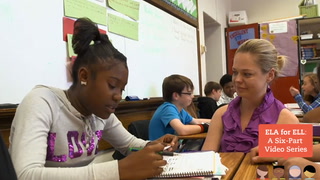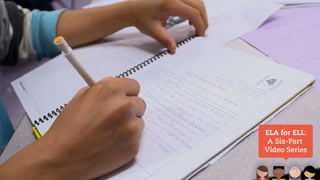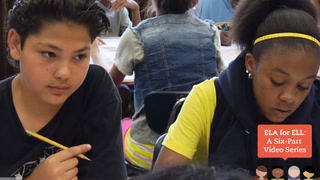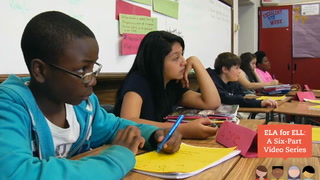Extending Understanding: Vocabulary Development Final Program Transcript
Langlois (INT): My name is Katie Langlois and I teach 7th grade at Morey Middle School. It's an urban school right in the middle of Denver. Our school as a whole and my classroom represents this also it's about a third white, a third black, a third hispanic. Often times those kids are English language learners, and I teach 7th grade Language Arts.
Langlois: Everyone in your group is going to get a card. Either A, a B, a C, or a D.
Langlois (INT): So in today's lesson, vocabulary that we reviewed was all thematically linked to the Gettysburg address. This unit on understanding language starts with the Gettysburg address and the first time they read it, they don't know what it's about. It's like reading Shakespeare for the first time where it's English but it doesn't really sounds like it and then after a few times they really get it and then you know, today was our last day of the unit and they're really dissecting the complex vocabulary words.
Langlois: …person A is going to read basically a clue. Everyone has, um, a clue.
Langlois (INT): They were in groups of four and they each had a different clue as to what the vocabulary word was. So the first one had the first letter of the word, the second student had how many syllables it was, the third student had the last letter of the word, and then the last student had the definition and then together they came up with the word.
Langlois: We'll do one together. Alexis, can you read the clue for me for what it says for number seven?
Student: The word starts with the letter P.
Langlois: P? Okay. [student], will you read the B clue for me?
Student: Yeah. It says this word has four, four…
Langlois: Four syllables. We don't know how many letters it is but it has four syllables. All right, Jericho, do you have the C clue?
Student: The last letter in, in this word is N.
Langlois: Is what?
Student: N.
Langlois: N. Okay. Great. So, [student], will you please read the D clue?
Student: Something that is suggested for consideration.
Langlois: Let's think as a class. What word having to do with the Civil War and the Gettysburg address, starts with a P, ends in an N, has four syllables, and is something that is brought up for consideration?
Student: We don't have a copy of, like, the address…
Langlois: I know. You don't have a copy of the address. I want you to be able to think of these words from the themes and the ideas that we've been talking about over the past few days.
Aida Walqui: Having now read the text several times through different activities it's time for them to extend their understanding and as they do that they engage in a series of activities but the one that we see in the video is the last activity and it is an activity that most teachers right now would find peculiar at the end of a unit.
Langlois (INT): They're dissecting the vocabulary after we've done the unit, which is something that's different for me. Before, I'd always pre-taught vocabulary to English language learners and, so that when they encountered the complex vocabulary in the text that they would be able to understand it and it's definitely a new way of thinking for me.
Langlois: We read the background about Lincoln, we read the background about the battle of Gettysburg, we read the background about the Civil War. Um, I'm hoping that you can get it from that. Alexis?
Student: Is it, like, propo- proposition?
Langlois: Great. Absolutely.
Aida Walqui: We begin with big ideas and we begin with engaging students in the discussion of these ideas and then we still pay attention to vocabulary so at the end of a lesson we come back and make sure that students have crafted, through the multiple participations, a workable definition of key terms.
Langlois: Does anyone remember the sentence off the top of their head that uses the word proposition? You think you have it Alexis?
Student: Is it, like, the proposition that all men are created equal?
Langlois: Yes. Exactly.
Aida Walqui: Rather than beginning with the bits and pieces, which will never amount to a solid whole, we begin with the big ideas first, with the big understandings about language and then we end with bits and pieces because we also want them to have proficiency in the forms of language.
Langlois: So what's going to happen now is whoever has the A card gets to choose which one you do, and you can do them in any order you want. You don't have to go one through twelve. And remember, especially for the person that has the D card, you have to wait for every single person to talk before you start suggesting what they are, because D card's really the one that gives the answer away, so that's where someone will know.
Student: I want to do eleven, which starts with the letter H.
Student: Okay. And B. Eleven right? This word has two syllables.
Student: The last letter in this word is W.
Student: It means to make holly. Or hollow. Hollow.
Student: …he said we cannot hollow this ground.
Student: No…
Student: To make holy. Hollow.
Student: Like hello?
Student: That's only two syllables.
Student: Have you ever heard of a cemetery? That's like hollow ground.
Student: …it is two syllables! Smart one.
Student: So let's trade cards…
Student: Six. The word starts with the letter L.
Student: Um, the word has two syllables.
Student: The last letter in the word is N.
Student: Um, we're doing…It is the last name of the president of the United States…
Student: Lincoln!
Student: Very smart Raven!
Langlois: Number one. I'll take someone from this group here. AJ.
Student: Slavery.
Langlois: Number two. Effran?
Student: secession.
Langlois: Secession. That was probably the hardest one.
Aida Walqui: Many times teachers think that students need to be grouped homogeneously and in fact a lot of work with English language learners is predicated that way. There are beginning classes - beginning one, beginning two, beginning three, beginning… whatever… and that really runs counter to what we know about second language development. Second language development works best when you have groups that are heterogeneous because that allows teachers to both sometimes group students in more homogeneous ways and sometimes group them in more heterogeneous ways. So in the video you see that there are not only English language learners but there are some speakers of African American vernacular English. And so in both cases and even in the case of Anglo students, there is the opportunity to pull differential strengths together for the benefit of the joint work.
Langlois: I'm gonna actually go back to this group right here. You guys did a number thirteen. You came up with your own. Can you give us the clues for that?
Student: Uh, it starts with an F.
Langlois: F?
Student: Yeah. It has two syllables and it ends in M. Does anyone have any ideas before I say the definition?
Langlois: F. Starts with an F and ends with an M.
Student: The definition is It means to be without restrictions or rules.
Langlois (INT): It was really cool because they were doing it instead of me just kind of feeding it to them.
Student: Freedom.
Langlois: Freedom. Good job.
Aida Walqui: It's really nice to see that in that class the teacher took it one step further and so a group of students actually comes up with their own other item for the jigsaw and so this is precisely what teachers can do. So students will look for terms and they will come up themselves with working definitions which by the way is a very high order thinking skills to define in what phrase the meaning of the word in the sense that we've been using it throughout the unit.
Langlois (INT): They're becoming more academic with their talk and their words are more scholarly. And, that's been rewarding for me. It's really cool. It really is.
- END -















36 Comments
christie DeVito Feb 18, 2020 2:37pm
1. students will have a workable definition of the word and will have proficiency in the forms of language
2. Students speak more scholarly using academic vobaulary
valerie vallejo-meza Jun 12, 2018 8:44pm
Denise Woods May 1, 2018 9:16pm
christie DeVito Feb 18, 2020 2:40pm
i agree with you not average lesson students acquire languag skills useful beyond lesson